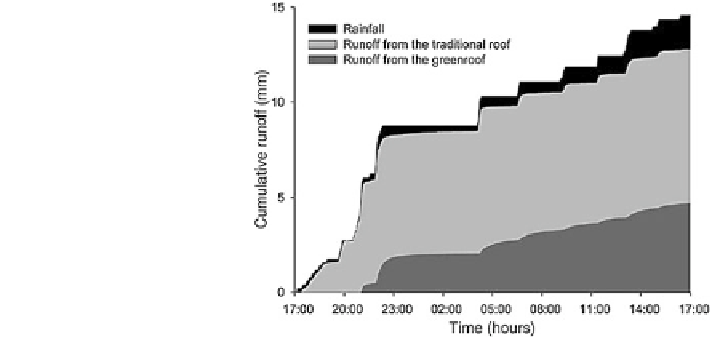Environmental Engineering Reference
In-Depth Information
Fig. 6.3 Cumulative runoff
as measured by Mentens et al.
(
2006
) on an extensive green
roof and a bare roof based on
a 14.6 mm rain shower
without cooling, indoor temperatures were found at least 3-4 C lower than the
outdoor temperature, which was between 25 and 30 C.
Green roofs can be used for the retention of water, and as a consequence, the
sewer system can be tailored to lower the peak concentrations and to improve the
water quality in the period of heavy rain. This subsequently can lead to savings on
investments in sewer and water purification installations (Heidt and Neef
2008
).
The retention capacity can be between 60 and 100 % depending on the con-
struction details of the green roof. According to Mentens et al. (
2006
) the reduction
of the runoff consist in: delayment of the initial time of runoff due to adsorption of
rainwater in the green roof system, reducement of the total runoff by retaining part
of the rainfall, and by distributing the runoff over a longer period of time through a
relative slow release of the excess water that is temporarily stored in the pores of
the substrate. The effect of a green roof on the runoff compared to a traditional flat
(bare) roof can be seen in Fig.
6.3
. Green offers furthermore a variety of plants and
animals; as a result of this many species can establish or maintain themselves in an
urban environment. The biodiversity in cities is generally higher than in agricul-
tural areas, but lower than in the rural area (Natuur balans
1999
). The urban area
offers a unique lodging to some specific types by the substrate (mostly brick,
limestone, and masonry (Darlington
1981
)) and the urban microclimate, such as
wall vegetation and mosses. One of the characteristics that set a city apart from its
rural surroundings is the altered climate that prevails over urban environments.
Comparing rural areas with the urban areas differences can be found in solar input,
rainfall patterns, and temperature.
The integration of buildings with vegetation, i.e., green roofs and vertical
greening systems, is a constantly evolving research field and especially in the last
decade a lot of technical developments are done. However, green envelopes
(especially the most innovative vertical greening systems) are not yet fully
accepted as an environmental quality restoration and energy saving method for the
built environment, mainly due to the lack of data needed to quantify their effects,

Search WWH ::

Custom Search